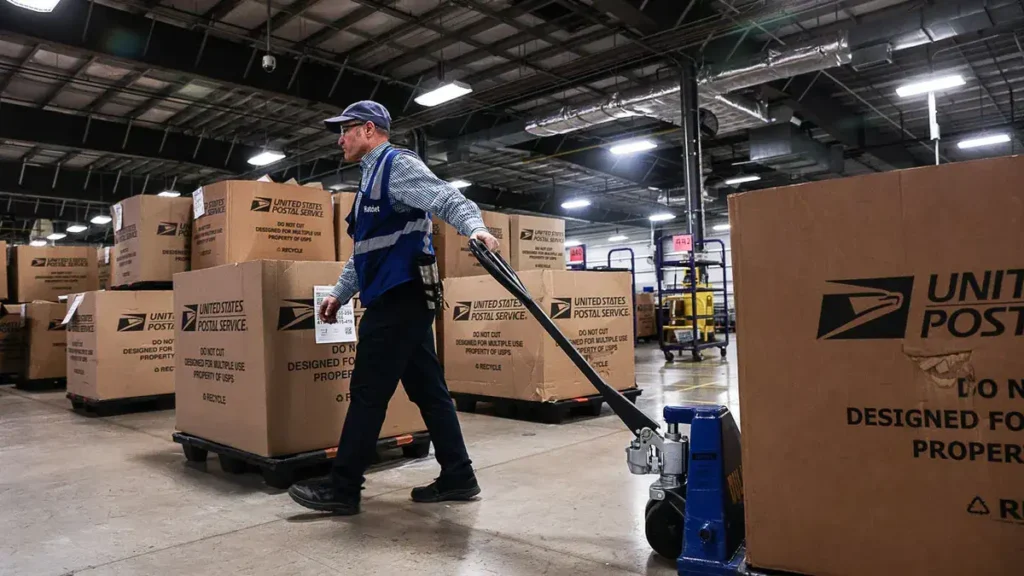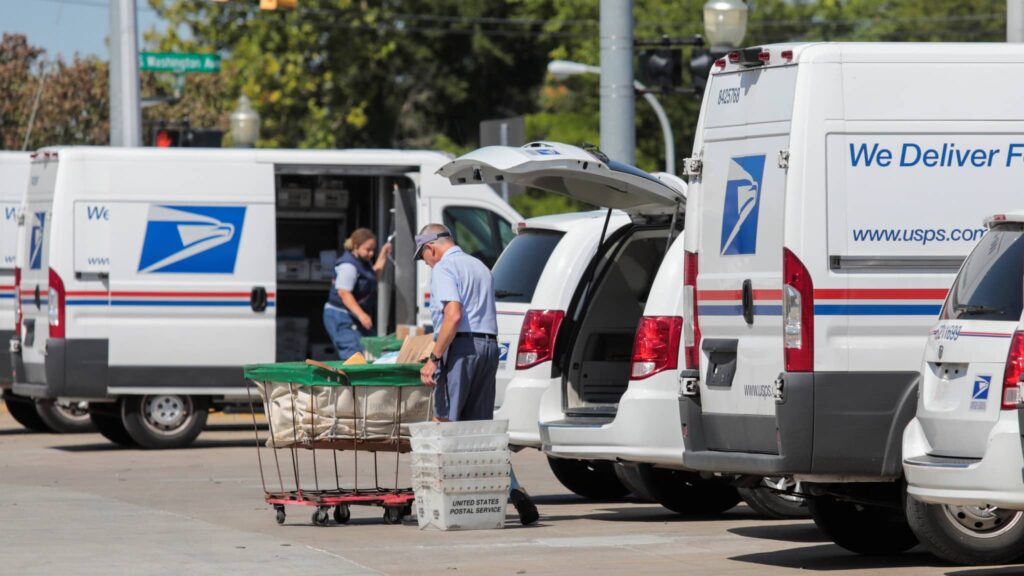In the Print on Demand (POD) business, understanding the structure of shipping costs is a key factor in maintaining stable profit margins especially during the year-end sales season. When USPS applies its Holiday Surcharge, many sellers risk “profit leakage” if they fail to adjust their pricing and fulfillment plans in time. So, what exactly is the holiday surcharge, why does USPS implement it, and what should POD sellers do to avoid losses during this peak period? This article will help you understand the reasons behind the surcharge, its effective period, and practical strategies to optimize your costs effectively.

What Is the Holiday Surcharge and Why Does USPS Apply It?
If you’re a POD seller who has experienced the Q4 sales season (from Halloween to Christmas), you probably know the “bittersweet” feeling: orders skyrocket, but so do shipping costs. Among those costs, the Holiday Surcharge is often the hidden factor that silently eats away at many sellers’ profit margins.
What Is the Holiday Surcharge?
The Holiday Surcharge (also known as the Peak Season Surcharge) is a temporary fee that shipping carriers such as USPS, FedEx, and UPS add to their standard shipping rates during the busiest months of the year typically in Q4.
This is not a hidden fee; it’s publicly announced and applies to everyone from major e-commerce corporations like Amazon, to fulfillment partners like FlashShip, and ultimately, to you as the seller.
Think of it as a kind of “entry ticket” to the peak season. When shipping demand surges, the operational cost of maintaining the logistics network also rises, and this surcharge is implemented to help carriers offset those additional expenses.
Why Does USPS Apply the Holiday Surcharge?

Many sellers mistakenly believe that this is simply a way for shipping carriers to “make extra money.” In reality, the explanation is far more complex and reasonable.
The USPS logistics network is designed to handle an average daily shipping volume. When the holiday season arrives, that volume can easily double, triple, or even more.
Imagine a restaurant that normally serves 500 customers a day suddenly having 1,500 walk in at once. To keep things running, the restaurant would have to:
- Hire seasonal workers: USPS must recruit tens of thousands of temporary employees to sort, process, and deliver packages.
- Increase transportation capacity: They need to lease additional trucks, airplanes, and expand sorting facilities.
- Pay overtime wages: Existing staff have to work longer hours, including weekends and holidays, at higher pay rates.
- Cover rising fuel costs: More trucks and more delivery routes mean significantly higher fuel consumption.
The Holiday Surcharge exists to cover these skyrocketing operational expenses. Without it, the USPS system would collapse under the pressure your packages would be stuck in warehouses for weeks, and shipping delays would become far worse.
Duration and Rate of the 2025 Holiday Surcharge
Each year, the United States Postal Service (USPS) announces its plan to implement the Holiday Surcharge during the year-end shopping peak the period when e-commerce orders surge to their highest levels.
For 2025, the USPS Holiday Surcharge will officially take effect on Sunday, October 5, 2025, and remain in place throughout the peak season, ending on January 18, 2026 (US Time).
The application of this surcharge comes as no surprise, as this is when the U.S. logistics system operates at full capacity. USPS must recruit additional staff, expand delivery routes, and strengthen parcel-handling infrastructure to accommodate shipment volumes many times higher than normal. The surcharge helps offset these operational costs and stabilize the strain on the supply chain.
For POD sellers, understanding the surcharge period and its pricing mechanism is essential to maintaining a healthy profit margin during the Q4 sales season. Typically, USPS categorizes surcharges based on shipping service (Ground, Priority, Express), package size and weight, and delivery zone. Shipments traveling long distances or weighing more tend to incur higher surcharges than lighter, in-state, or short-haul packages.
Importantly, the Holiday Surcharge is not a fixed rate USPS updates its rate chart each year based on transportation conditions and market costs. Therefore, sellers should monitor USPS’s official announcements as early as Q3 2025 to stay informed and adjust product pricing, fulfillment schedules, and marketing campaigns accordingly.
How Does the Holiday Surcharge Affect POD Sellers?

The Holiday Surcharge isn’t just a few extra cents for POD sellers, it’s a “hidden cost” that can completely disrupt your Q4 financial plan.
Increased Shipping Costs
This is the most obvious and painful impact. In the POD model, shipping costs are a fixed part of your Cost of Goods Sold (COGS).
Typically, a POD apparel order in the U.S. has a base shipping cost ranging from $4.50 to $7.50, depending on the fulfillment partner and the shipping service used. Once the Holiday Surcharge takes effect, that same order can instantly rise to $6–$8.20, even with identical product weight and service level.
If a seller keeps the same retail price without making adjustments, that entire increase is directly deducted from their profit margin. In such a competitive market, this surcharge alone can reduce your profit by 10–15%. The situation becomes even worse if you’re also running ads, as CPC/CPM costs surge sharply during Q4.
Let’s do a quick calculation: A store that sells 500 orders per week with an average net profit of $3 per order will lose $250 per week if shipping costs rise by just $0.50 per order. That’s roughly $1,000 per month a significant amount of profit that “vanishes” simply because of a surcharge you might have overlooked.
Delivery Delays
The Holiday Surcharge exists because the USPS system becomes overloaded and when that happens, not only do costs rise, but delivery times inevitably slow down. During the holiday season, it’s completely normal for packages to be delayed by 1–3 days beyond the estimated delivery date.
However, U.S. customers during the holidays are extremely time-sensitive. They’re ordering gifts for Christmas or Thanksgiving, and a delayed package often means a gift that doesn’t arrive on time. This immediately leads to:
- A flood of “Where is my order?” (WISMO) messages.
- Impatient customers leaving 1-star reviews and negative feedback.
- A spike in refund requests and disputes.
For POD sellers on highly competitive platforms like Etsy, Amazon, or TikTok Shop US, shipping delays can directly impact key store metrics. You could lose credibility scores, badges (like Etsy’s Star Seller), or even face reduced product visibility all of which can choke your revenue flow.
Increased Return and Reprint Costs
The holiday season also means more gift purchases, which naturally drives up return rates (often due to incorrect sizing). Combine that with delayed deliveries, and your risks multiply.
If an order arrives after Christmas, the customer may no longer want it and request a return. If the package is lost or damaged during the rush, you bear the cost. In the POD model, this doesn’t just mean losing the shipping fee you’ll also absorb a second fulfillment cost, including both reprinting and reshipping the product.
The loss per failed order in these cases can be substantial, especially when multiplied across dozens or hundreds of delayed shipments.
Disrupted Pricing and Advertising Strategies
This is the most silent yet the most dangerous trap. Many sellers focus heavily on running ads, see sales spike, and celebrate a “sales storm.” However, they often forget to recalculate their COGS (which now includes the holiday surcharge) when evaluating their campaign profitability.
As a result, many only realize they’ve been losing money after the sales season is over, when all expenses are tallied up. They’ve spent thousands of dollars on advertising to drive orders that actually carried negative profit margins.
High revenue but zero or even negative net profit is a common nightmare for sellers who fail to account for the Holiday Surcharge in advance.
What Should POD Sellers Do to Avoid “Losing Profit” During the Holiday Season?

Knowing the risks is one thing but taking action to protect your profit is another. So how can you navigate this challenging period of holiday surcharges while still maintaining healthy Q4 margins?
The answer lies in proactive preparation and a smart, data-driven strategy.
Below are four practical and urgent strategies that every POD seller should start implementing right now.
Recalculate Your Product Pricing Structure
The first and most crucial strategy: never absorb the loss. Many sellers make the mistake of thinking they can “swallow” a few extra cents in shipping costs to stay competitive. But when multiplied by thousands of orders, those “few cents” can quickly turn into thousands of dollars in lost profit.
You must accept that the Holiday Surcharge is a temporary part of your Cost of Goods Sold (COGS) and pass it on to your final retail price.
Don’t wait until Black Friday to act. Update your shipping rate tables at least one to two months before the peak season begins. This gives you enough time to test and ensure that all your shipping profiles on Etsy, Shopify, or Amazon are accurate and up to date.
The best approach is to slightly increase your retail prices. A 5–10% adjustment is usually acceptable to customers during the holiday season or you can simply add the estimated surcharge directly into your product price. For instance, instead of keeping your price at $24.95, adjust it to $25.95 or $26.45. It’s a small difference for the buyer, but it allows you to maintain a stable profit margin across all orders.
To preserve customer trust, transparency is key. Clearly include a short note such as “Holiday Shipping Update” or “Seasonal Rates Apply” on your product page or store announcement section. Most customers will understand that this is a normal and temporary adjustment during the high-demand holiday period.
Prioritize U.S. Domestic Fulfillment
Finally, this may be the most effective and safest strategy, especially for Vietnamese sellers targeting the U.S. market: prioritize domestic U.S. fulfillment.
When your products are fulfilled from a facility located within the United States, you immediately eliminate many operational risks. You’re no longer subject to import duties or the high cost of cross-border shipping. Instead, you benefit from much lower domestic shipping rates and far less exposure to international logistics disruptions.
Most importantly, you significantly shorten delivery times. Instead of customers waiting 2–3 weeks, your orders can be delivered in just 2–5 days. This speed is a crucial factor in retaining customers and earning 5-star reviews during the holiday season.
FlashShip is a U.S.-based fulfillment partner specifically designed to help Vietnamese sellers overcome these challenges. With an optimized production process that can complete orders in as little as one business day, and domestic U.S. shipping within 2–5 days, FlashShip helps you maintain both profit and reputation, even as USPS increases its surcharges turning Q4 into a truly profitable season.
Understanding and proactively responding to the USPS Holiday Surcharge allows POD sellers not only to preserve profit margins but also to ensure operational stability throughout the busiest sales season of the year.
Don’t let hidden fees eat into your earnings — prepare early, optimize your costs, and partner with a reliable U.S. fulfillment provider.
Contact: (+84) 943 024 337
Visit: FlashShip.net for detailed consultation and product pricing.

